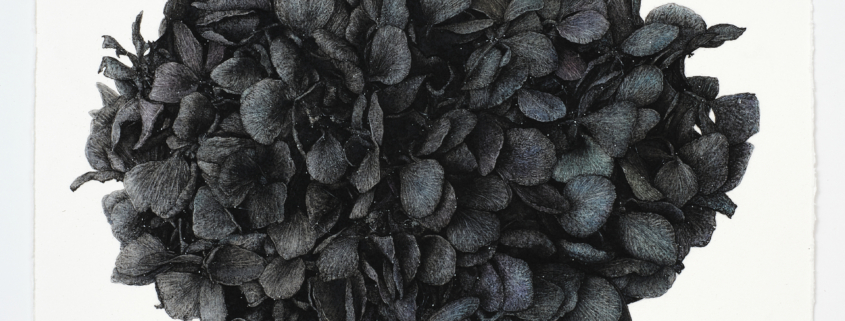
Sanderson are pleased to present the solo exhibition After the Garden by Liam Gerrard.
Based in Tāmaki Makaurau Auckland, Gerrard is celebrated for his ability to wield a pencil, piece of pastel, or stick of charcoal to capture and distil the breathing, humming, three-dimensional natural world onto paper. Elements that are deeply familiar, but rarely centre stage, come into sharp focus – the fuzzy patina of a moth’s wing, the crisping petal bonnet of a kōwhai flower, the whorl of an ear, or the bent articulation of a finger.
The lingering influence of the Pre-Raphaelites is felt in Gerrard’s figures, as it is in his detailed, concentrated focus on the natural world. The Pre-Raphaelites, a group of young artists, poets, and art critics in the Victorian period, rejected the expected, idealized version of the world in favour of an uncompromising and unprecedented realism that made them Britain’s first avant-garde art movement. They often drew their subjects from mythology, Christianity, and literature, but they were transmuted through a painstaking prism of realism; through a dogmatic adherence to the dictum “truth to nature.” The result in many of the groups’ paintings is a harmonious melding of portraiture with landscape art, where figures are expertly rendered and all species of bird, plant, and tree are readily identifiable.
Much of Gerrard’s new suite of works has a local immediacy: the hydrangeas (Hydrangea macrophylla) are instantly recognizable, flowering as they do across a wide expanse of New Zealand Aotearoa in the summer months, while kōwhai (Sophora tetraptera), a native, spring-time bloom, is frequently cited as the country’s national flower. The artist’s interest in the natural world, and, more specifically, in Aotearoa’s native flora, is a longstanding and central part of his practice. As a child, he graced the cover of Andrew Crowe’s 1994 publication What Native Forest Plant? Appearing alongside his mother, who herself worked in publishing, was an avid gardener, and was largely responsible for directing Gerrard’s attention to the plant life that surrounds him. In Tawari St, Mt Eden I and Tawari St, Mt Eden II we are greeted by knobby snippets of wood, serpentine stamens, and caps and petals that are dusty and desiccating. A glimmer of the iconic, buttery yellow remains, but a ghostly grey also slowly marches over it. As in all of Gerrard’s work, this onset of age and decay is startlingly beautiful. It is a poignant reminder that time is fleeting.
Thematic and stylistic echoes are also apparent in Gerrard’s stunning new work Still in Every Sense. Here, a confluence of truncated figurative forms coalesces into a patchwork that borders on the abstract. Feathers, human hair – both chestnut and auburn – and a tumbling mass of hydrangea petals envelop most of the two female figures, but we are gifted an aquiline nose, a curled ear, and one deep-lidded eye that gazes resolutely out of the picture plane and away into the distance beyond our own sightline. Along with Pre-Raphaelite elegance, the work is redolent of the Victorian photographer Julia Margaret Cameron – a recurrent source of inspiration for Gerrard – who famously moulded her sitters into classical, religious, or literary characters, and who favoured a close-up format and soft focus. Many of her portraits, like Gerrard’s Still in Every Sense, are marked by a monumental silence and tranquillity, and by an inherently sculptural dimension. In Our Share of Night this atmospheric quality is woven through with a thread of the macabre and fantastical that speaks to the influence of fellow Victorians William Blake and the French artist Gustave Doré. Irrespective of subject matter, however, Gerrard imparts all of his work with a stillness, with a quiet pulchritude; they are serene, self-possessed, other-worldly.
These are meticulous, thoughtful ruminations on the inexorable passing of time, on societal concepts of beauty and desire, and on the endless variety and motion of the natural world. There is mystery and splendour here, as with all of Gerard’s work. His works radiate with a tenderness, with consummate skill, and with an unwavering commitment to rendering the seemingly impossible completely possible. A magician’s trick. In the process, Gerrard preserves a piece of nature and a slice of time that endures well beyond its fleeting moment in the physical world. Indeed, the motto that Millais chose reverberates throughout: Ars longa, vita brevis (life is short, but art endures).
Read the full exhibition essay by Dr Jemma Field here.
To request a catalogue please email info@sanderson.co.nz




